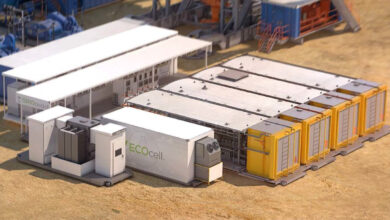By Diane Langley, editorial coordinator
Besides exploring for and producing energy resources, the energy industry is tasked with debunking myths and clarifying techniques used in hydraulic fracturing. Brian Petty, IADC executive vice president for government affairs; Lee Fuller, vice president for government relations for the Independent Petroleum Association of America (IPAA); Bob Moran, vice president for governmental affairs for Halliburton; and David Adams, vice president of product enhancement for Halliburton, spoke with Drilling Contractor regarding the politics of hydraulic fracturing.
Even though the US Environmental Protection Agency (EPA) has thus far not imposed a federal regulatory system usurping states’ regulatory authority in the area of hydraulic fracturing, the debate between the energy industry and environmentalists rages on.
According to Mr Petty, the recent debate seems to have commenced with a determined move during the 111th Congress to have the EPA impose a regulatory system. The Congressional environment has changed for the better since then, he said. However, the debate continues.
According to proponents of hydraulic fracturing, the facts surrounding chemical use are clear – water and sand comprise the majority of the mixture used. The remaining components used to deliver the water down the wellbore and position the sand in fractures created in the formation – while they can probably be found in the kitchen cupboard – are proprietary ingredients.
US environmentalist and civic community groups are seeking specific chemical disclosure and supporting lawsuits of potential drinking water contamination. Questions are also being raised regarding the use, reuse and disposal of water in the process of fracturing. These requests for proprietary information and questions regarding water use are muddying debate resolution.
“There are several ongoing debates,” Halliburton’s Mr Moran said. “There is an argument from anti-fossil nongovernmental organizations suggesting that the nation’s energy policy should rely solely on renewables without the use of any fossil fuels. There’s also an emotional versus technical debate under way where industry needs to do a better job of informing the public about its safe operations.”
What does the US government say about hydraulic fracturing? The EPA has been undertaking a federal study for about two years that seeks to examine the full life cycle of water in hydraulic fracturing, from water acquisition through the mixing of chemicals and actual fracturing to the post-fracturing stage, including the management of flowback and produced water and its ultimate treatment and/or disposal.
Interestingly, the EPA had already concluded a study of coalbed methane (CBM) hydraulic fracturing environmental risks in 2004. The EPA limited its study, according to IPAA’s Mr Fuller, to CBM partly because the court cases were directed toward CBM operations and partly because, if hydraulic fracturing environmental risks existed, they would occur in the shallow coalbed fields.
The results of that study were straightforward, Mr Fuller said. The EPA reported that “the injection of hydraulic fracturing fluids into coalbed methane wells poses little or no threat to US drinking water supplies and does not justify additional study at this time.”
The debate at the state level centers on the fact that hydraulic fracturing is regulated by individual states because each state’s geology is different. Fracturing has been going on for 60 years without incident, Mr Petty said. Still, environmentalist groups continue to push for chemical disclosure and generate publicity of possible drinking water contamination from hydraulic fracturing operations.
According to Mr Fuller, states are very aggressively stepping into the debate over disclosure of chemicals. Some states, such as Wyoming and Arkansas, are creating their own chemical disclosure rules. Partly as a response to these actions unfolding around the country, the Ground Water Protection Council and the Interstate Oil & Gas Compact Commission, both organizations made up of regulators, are creating a national registry to provide information on a well-by-well basis regarding composition of fracturing fluids.
“We’ll see if this (disclosure) was really an issue or whether this has been an opportunity to try to terrorize communities,” Mr Fuller remarked.
What is hydraulic fracturing?
A process developed in the 1940s and used for more than 60 years, hydraulic fracturing is a highly engineered and well-understood technique that allows natural gas and oil to move freely from rock pores, where they are trapped, to the producing well. A fluid – usually water with a minute specialty additive component – is pumped at high pressure into a formation through manmade fractures.
The pressure of this fluid cracks the rock and opens small fractures in the rock. A sand-like substance is then injected to prop the cracks open to prevent the rock from collapsing back onto itself. With the propping agent (sand) holding the rock open, the gas or oil is able to flow through the fractures to the well and up to the surface.
This use of this technique allows improved hydrocarbon recovery and production of greater volumes from wells. And, according to the IPAA, hydraulic fracturing is the linchpin to production from shale-gas formations, which is the fastest-growing component of American natural gas.
What’s at stake in the US
“This is really a debate on a much larger scale; it has a bearing on the future of gas and perhaps oil as well,” Mr Fuller said. “The history of fracturing as an environmental issue is one that has shown that it has been effectively regulated, that the technology hasn’t created any environmental risks that haven’t been well managed. It’s a very benign history. I’ve been involved in environmental debates for 30-some years, and I’ve never seen a technology that has a more well-defined and effective construct associated with its regulation that has been characterized as such a threat. And that tells me that we’re really not dealing with fracturing here; we’re dealing with fracturing because it is such a linchpin to the development of American natural gas and oil resources. If fracturing can be inhibited in some way, this will inhibit all production.”
“The risk is being grossly misstated in an effort to terrorize communities and demean state regulators,” he continued. “What’s at stake is whether we’re willing as a nation to develop our resources. This is the time to recognize that we have the capacity to produce 100 years of natural gas. We’ve seen oil production increase for the first time in 20 years, and that is largely due to the combined use of horizontal drilling and sophisticated hydraulic fracturing. We can reduce the environmental footprint with these technologies; that’s a critical choice for the country to make.”
Mr Petty agrees. “What is at stake is the energy base of this country,” he said. “Especially in the wake of what’s happened in Japan … the nuclear industry has fallen back into disfavor. It’s unfortunate, but it’s a political fact. And so if you’re not going to develop new nuclear plants, and they could only be developed with government assistance, and gas is a clean-burning fuel, this is what we need to support new energy generation.”
“What’s at stake for the energy industry is that companies have made big bets on the promise of shale gas in this country. … A lot of promising fields have come about because of this technology,” he continued. “That gas is ‘gettable’; there’s a lot of it, it’s reliable and sustainable.”
Hydraulic fracturing has made it possible for many communities to see economic gains due to production of oil and gas. According to Mr Petty, the shale plays have brought jobs. Royalties and taxes paid to the counties and property owners in states where hydraulic fracturing techniques are being used for energy development have resulted in a positive economic boost.
David Adams of Halliburton believes that, from a US perspective, hydraulic fracturing “has opened the doors to a better quality of life; it can do the same thing internationally. … I don’t think the general public is aware of what hydraulic fracturing has done for the industry and everyday life. In 2003 the industry was estimating that we were about to run out of gas … but we’ve recognized over the last few years that there’s an abundance of gas in the shale plays, and with new technologies, we’ve found the same about oil.”
“When you distill this debate down,” Mr Moran of Halliburton said, “you’re looking at a domestic energy resource and the creation of jobs. You’re seeing economic benefits to the communities and states where development is occurring. You’re seeing national benefits of increased energy development and security. You’re seeing advancements in investments in newer technologies to improve this operation.”
Lack of potential for drinking water contamination
According to Mr Petty, the chemical disclosure issue surfaced in 2001 in a court case in Alabama in which the court declared that hydraulic fracturing must be regulated under the Safe Drinking Water Act, which categorically excluded hydraulic fracturing from federal regulation. “But there was no scientific evidence to support that, and the EPA conducted a study that concluded in 2004 which validated that there is no risk to drinking water resources, even stating that use of the fracturing technique does not encroach upon drinking water resources,” he said.
Because one federal court case in 2001 created confusion in the matter, the 2005 Energy Act was issued. The act basically restated the exclusion of the oil and gas industry from the Safe Drinking Water Act, according to Mr Petty, a law that had been in place for 30 years.
Further, he continued, the Ground Water Protection Council, a group of 30-plus state environmental agencies, has declared numerous times that the hydraulic fracturing procedure poses no threat to drinking water.
Is there more to the debate?
“The debate that has been framed of late is because we have a dedicated group of environmental organizations who are hell bent on shutting down the production of hydrocarbons in this country,” Mr Petty said. “There have been constant calls to reveal the so-called ‘poisonous toxic’ chemicals that are used in this procedure.”
The EPA’s intended research “goes well beyond relationships between hydraulic fracturing and drinking water,” Mr Fuller said. “Not only have public debates grossly mischaracterized the nature and risks of hydraulic fracturing, but we can’t actually point to a single case of drinking water damage as a result of the hydraulic fracturing process.”
The conflict over hydraulic fracturing is really just one part of a larger effort, according to Mr Fuller. “We’ve seen, particularly over the past five to seven years, a very aggressive state and local targeted process primarily focused on hydraulic fracturing because it’s got such a linchpin role in the development of our shale formations. If you stop fracturing, you can stop that development.”
To disclose or not to disclose
“What the environmentalists are trying to do is ask that every chemical in the stimulation ‘cocktail’ be disclosed publicly by its Chemical Abstract Services (CAS) number,” Mr Fuller said. “And that is where they start reaching into the proprietary protection issues and companies’ ability to perform. … It’s an attempt to abuse the opportunity to get good information by trying to get more than is really needed.”
The burden of disclosing chemical use can be put on the producer or the service company. States have been trying to require information from the producer or the service provider without breaching proprietary issues. States also have been generally gathering chemical information as part of the well construction permitting process or through well completion reporting.
“What will happen if people try to force disclosure of things that are proprietary is that those more sophisticated (stimulation) mixes will be pulled out of markets where that disclosure has to occur,” Mr Fuller said. “On the one hand, (the disclosure issue) has become a big tactic on the part of the environmental community to try to suggest that, by not disclosing, there must be something dangerous to a community even though the exposure pathways are regulated effectively by the state.”
“Halliburton spends tens of millions of dollars each year on R&D focused on engineering the next generation of stimulation solutions, including reducing the amount of water needed at the wellsite and related fracing issues. We have a clear interest in the company operating under conditions that allow us to compete,” Mr Moran said.
Mr Adams also commented, “We want to be as forthright as we possibly can, and, at the end of the day, we do disclose. And we disclose fully from the regulatory perspective and are compliant with that. In the instance of state-by-state disclosure regulations, we’ve worked out confidentiality agreements with those states that require disclosure. This allows us to disclose everything associated with the chemistries under strict confidentiality. And that’s all we’re looking for. We just want to be able to protect the technology and the investment dollars we put into this technology and keep it out of the hands of our competitors.”
Will this issue arise in the international arena? “We’re already seeing that,” Mr Adams said. “What’s really helping us is that we are quickly trying to provide the information and are educating the regulators, legislators and general public in those areas as well. What it comes down to is a fear of the unknown. The more education and information that can be provided, the better off everyone will be.”
Regulatory challenges

According to Mr Fuller, the disclosure debate is being pursued at a very public level. States are moving to require disclosure, and “that’s the right place to do it,” he said. “The state regulatory process is part of the well construction process where there is no federal regulation except on federal land.”
What’s the issue with federal regulation? If information should need to be put into a national database, there is no system to receive that information and manage it, according to Mr Fuller. “It would have to be created in addition to the ones that the states have already created. … Hopefully, since most of the information is already reported to the states, the federal government will see the wisdom of using the states’ registry.”
“It’s important to keep a balance between building public confidence and transparency of the process of what we’re doing and what we’re using and also promoting a climate that incentivizes the sizable investment that we’re making in these technologies,” Mr Moran said.
Industry, joint initiatives
The energy industry is speaking up through a number of initiatives. In addition to the national registry being compiled by the states, the industry is an active participant in a program called STRONGER (the State Review of Oil and Natural Gas Environmental Regulations). Comprised of a team of state regulators, environmental participants and industry members, the group was formed to create guidelines with which to measure regulatory programs and make recommendations on items that need to be adjusted or to commend states on regulations that they have in place. According to Mr Fuller, the group amended its scope last year to include hydraulic fracturing.
The American Petroleum Institute also has issued several new recommended practices during the past year and a half that are designed to review hydraulic fracturing operations and well construction, cementing and casing standards and water management, to name a few.
On a broader scale, the Energy In Depth website was established by industry organizations to get information on oil and gas development, particularly hydraulic fracturing, to a variety of stakeholders, including the public, media, legislators and regulators. “It was put together as a mechanism to disseminate information, make it public, and respond to and monitor what’s happening around the country to quickly rebut mischaracterizations,” Mr Fuller said.
As summed up by Mr Moran, “We continue to work at the state and public level to make sure that positions and policies don’t have a chilling effect on technology and the investment in that technology.”




